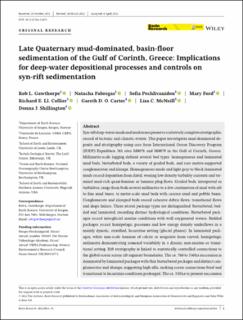| dc.description.abstract | Syn-rift deep-water muds and mudstones preserve a relatively complete stratigraphic record of tectonic and climatic events. This paper investigates mud-dominated deposits and stratigraphy using core from International Ocean Discovery Program (IODP) Expedition 381 sites M0078 and M0079 in the Gulf of Corinth, Greece. Millimetre-scale logging defined several bed types: homogeneous and laminated mud beds, bioturbated beds, a variety of graded beds, and rare matrix-supported conglomerates and slumps. Homogeneous muds and light grey to black laminated muds record deposition from distal, waning low density turbidity currents and terminal mud-rich quasi-laminar or laminar plug flows. Graded beds, interpreted as turbidites, range from beds several millimetre to a few centimetres of mud with silt to fine sand bases, to metre-scale mud beds with coarser sand and pebble bases. Conglomerate and slumped beds record cohesive debris flows, transitional flows and slope failure. Three stratal package types are distinguished: bioturbated, bedded and laminated, recording distinct hydrological conditions. Bioturbated packages record interglacial marine conditions with well oxygenated waters. Bedded packages record hemipelagic processes and low energy density underflows in a mainly dysoxic, stratified, lacustrine setting (glacial phases). In laminated packages, white mm-scale laminae of calcite or aragonite from varved, hemipelagic sediments demonstrating seasonal variability in a dysoxic non-marine or transitional setting. Rift stratigraphy is linked to eustatically controlled connections to the global ocean across rift segment boundaries. The ca. 780 to 330 ka succession is dominated by laminated packages with thin bioturbated packages and distinct conglomerates and slumps, suggesting high sills, making ocean connections brief and transitional to lacustrine conditions prolonged. The ca. 330 ka to present succession shows well developed bioturbated and bedded packages, separated by thin laminated packages, suggesting brief transitions and well-developed marine conditions due to lower sills. Results indicate that structurally controlled rift segment boundaries exert a first-order control on syn-rift stratigraphic evolution, with fault segment growth and linkage driving intra-rift facies and sequence variability. | en_US |

